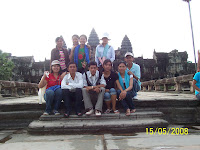

Cambodian hill tribes and totem poles - northern Cambodia
Most of north-eastern Cambodia has yet to be discovered by the outside world. It's a remote area where Cambodian hill tribes live in isolation. Each Cambodian hill tribe has its own language, culture and traditions. Although their traditional dress isn't as colourful as that of the mountain tribes in Thailand or Vietnam, their culture is just as interesting and perhaps even more rustic and authentic. During your Cambodia trip from Phnom Penh to southern Laos, add this module to your itinerary as a detour; it's a worthwhile addition for those with a little more time to spend here and who are looking for less well known areas in Cambodia. From Stung Treng in northern Cambodia you'll travel by car to Banlung, where refreshing waterfalls and the Tampuan Cambodian hill tribes will be visited.
Kratie
The river is home to Irrawaddy dolphins, fish, and birds. The province is mostly covered in dense forest. Kratié is known for its attractive riverside scenery and its green villages and paddies.
Ratanakiri
Ratanakiri has been occupied by the highland Khmer Loeu people, who are a minority elsewhere in Cambodia. Ratanakiri Province was created in 1959 from land that had been the eastern area of Stung Treng Province. Larger-scale agriculture occurs on rubber, coffee, and cashew plantations. Khmer Loeu typically practice subsistence slash and burn shifting cultivation in small villages of between 20 and 60 nuclear families.
Mondulkiri
80 percent of the Mondulkiri's population is made up of ten tribal minorities, with the majority of them being Phnong. The remaining 20 percent are Khmer, Chinese and Muslim Cham. The population lives off the land, planting rice, fruit trees and a variety of vegetables. Others grow strawberries, coffee, rubber and cashew nuts. 80 percent of the Mondulkiri's population is made up of ten tribal minorities, with the majority of them being Phnong. The remaining 20 percent are Khmer, Chinese and Muslim Cham. The population lives off the land, planting rice, fruit trees and a variety of vegetables. Others grow strawberries, coffee, rubber and cashew nuts.
Many majestic waterfalls are found in Mondulkiri.
- Bou Sra Waterfall: Located at Pich Chinda District, 43 kilometers from Senmonorom town, Bou Sra is the largest waterfall, made famous by a popular Khmer song in Mondulkiri and has two stages.
- Senmonorom Waterfall: 5 km from town and an easy walk, is not much to look at and used to be a nice picnic spot until the Japanese built a hydro electric power station there and stole all the water.
- Romnea Waterfall: 10 kilometers from Senmonorom, is actually 1 of 3 large waterfalls that has now been deforested and privatised by a Guesthouse.
Stung Treng is located on a high sandy bank overlooking the Mekong River, where it is joined by the Se Kong river. It is about 400 km from Phnom Penh and 40 km south of the Laos border.




